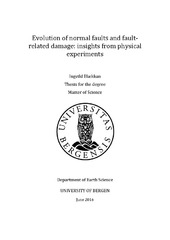| dc.description.abstract | Our understanding of the growth of natural extensional faults is limited to the study of a random snapshot in time, namely that of present day, aided by various techniques to reconstruct fault growth history. Furthermore, whilst the growth of faults may to some extent be reconstructed, the evolution of fault-related damage is harder to reconstruct and less well understood. In this study we use physical analogue plaster models to study fault evolution in extensional regimes in time and space. The resulting fault systems have been analysed based on photos, videos, and the final preserved model itself. Fault growth analyses from the plaster models show that not all faults follow the same pathway for growth. Some faults link up with adjacent faults and grow via sympathetic increase of displacement and length, whereas others show a more rapid establishment of the final fault length, with only minor fault tip propagation as additional displacement is accumulated. Other faults use some time to establish their final fault length, and once the length is established, displacement is accumulated. A characterisation of the topology of fault and fracture networks in analogue single-phase models is quantified. The results show that the proportion of splaying and abutting nodes (Y-nodes) increases at the expense of isolated nodes (I-nodes) as the strain increases. These changes are especially noticeable in the hanging wall to the main fault in the studied system. Also the proportion of fully connected branches (C-C branches) and partly connected branches (I-C branches) increases with increasing strain whereas the proportion of isolated branches (I-I branches) decreases. This emphasises that the connectivity in a fault and fracture network increases with increasing strain. Contour plots of connecting node frequency and branch intensity from the analysed models gain insight into the spatial distribution of areas with higher connectivity. These plots reveal that areas with high connecting node frequency coincide with areas with high branch intensity, suggesting that the connectivity increases with increasing deformation. Based on the analysis of analogue plaster models, it becomes clear that such forward modelling provides valuable insight into fault and damage-zone evolution that can be used to get a better understanding of fault growth, damage evolution and connectivity. | en_US |
